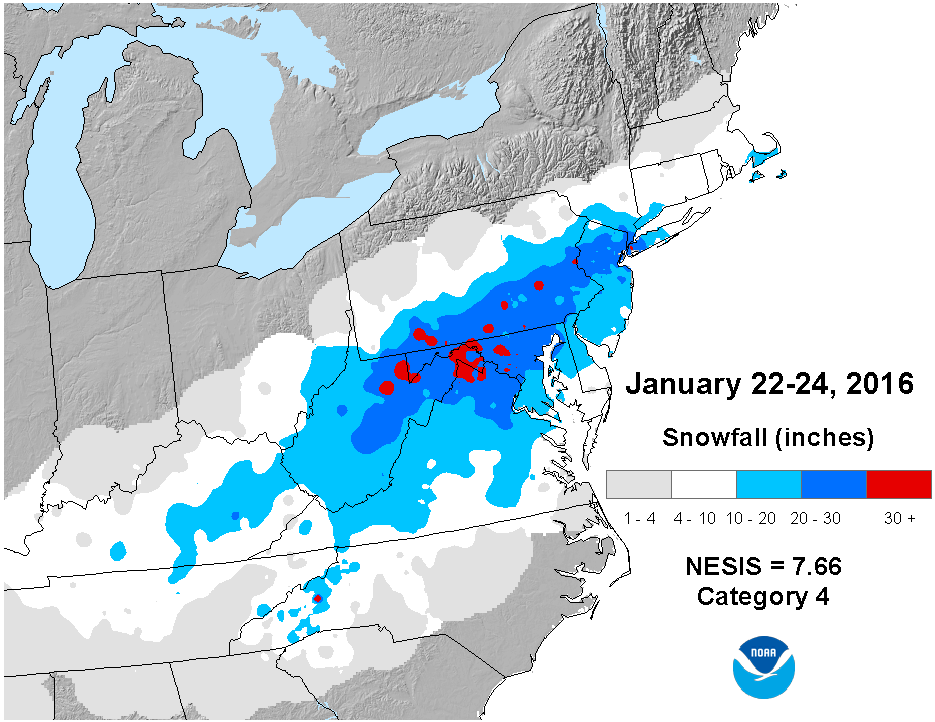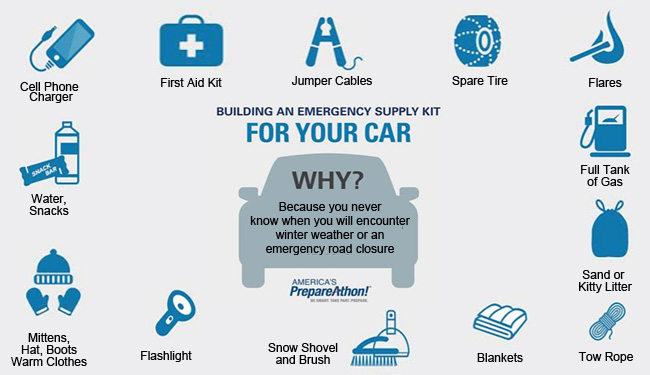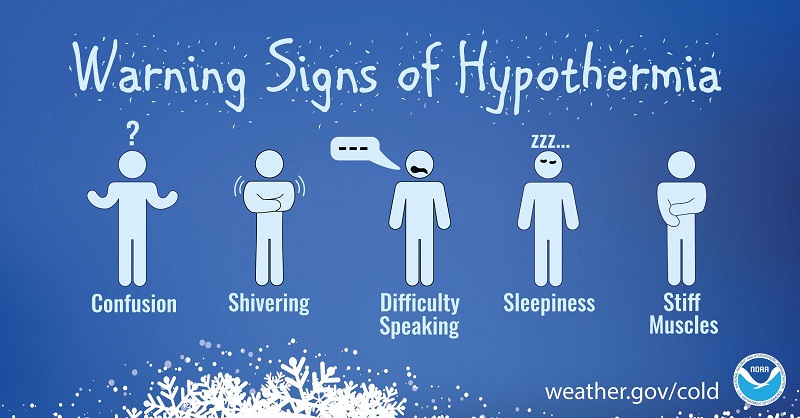Prioritize...
When you've completed this section, you should be able to discuss the criteria needed for a true blizzard and be able to identify the recommended components for an emergency supply kit for a car. You should also be able to describe wind chill and identify the signs of hypothermia.
Read...
How do you feel about winter weather? Do you like big snow storms? Do you hate shoveling snow? Do you love cold weather, or have you tried to avoid it by moving to an area where it rarely gets cold? Regardless of your feelings on these questions, winter weather can be downright dangerous. Wintry precipitation can create hazardous driving conditions. Ice storms and / or strong winds can knock out power for days, perhaps leaving you without heat for your home. Bitterly cold air can cause frostbite and / or hypothermia for those overexposed to the cold. Perhaps you've experienced such conditions yourself or know someone who has.
Given that winter weather can literally bring "life and death" situations, I want to briefly discuss winter weather safety. Knowing how to prepare for the hazards of winter weather could save your life! The National Weather Service maintains an extensive site on winter weather safety, covering big snow storms, ice storms, blizzards, avalanches, and extreme cold, and I encourage you to check it out and follow the tips provided. Here, we're going to focus on some general things you can do to prepare an emergency supply kit for your car and identify the signs of hypothermia, which is caused when your body temperature becomes dangerously low, typically because of prolonged exposure to cold.
Before we get into those topics, however, did you notice that I separated "big snow storms" and "blizzards" in the list above? There's a reason I kept them separate. You see, the term "blizzard" tends to be overused. In order to qualify as a "blizzard," a very specific set of criteria must be met. Specifically, a blizzard requires at least three consecutive hours of:
- sustained winds, or frequent gusts, of 35 miles per hour or more
- visibility of 1/4 mile or less due to falling or blowing snow
So, a blizzard can actually occur when snow is not falling if strong winds (at least 35 miles per hour) can blow snow already on the ground around enough to reduce visibility to 1/4 mile or less for three consecutive hours. Many snow storms that dump heavy snow get referred to as "blizzards" but may not be blizzards at all (or may only be blizzards over a small fraction of the affected area). For example, the storm commonly known as the "Blizzard of 2016" dropped more than 10 inches of snow from Kentucky all the way to southern New England (check out the snowfall analysis below).

But, was it really a blizzard? Yes, but in a much smaller area than you might think. This plot shows the number of hours of "near blizzard" conditions recorded during the storm. Blizzard conditions occurred from Nantucket and Martha's Vineyard in Massachusetts, to areas of Long Island, New York, to isolated areas of New Jersey and Virginia. Outside of those areas, it was a disruptive, heavy snow storm, but not really a blizzard. The fact is, most heavy snow storms are not actually blizzards because it's really difficult to sustain winds (or to experience frequent gusts) to 35 miles per hour or more AND maintain visibility of 1/4 mile or less simultaneously for three consecutive hours. Meanwhile, blizzards can actually occur when snow is not falling at all (often called "ground blizzards"). Back in 2013, Dr. Jon Nese of Penn State's Department of Meteorology and Atmospheric Sciences created a short video (3:31) on the overuse of the term "blizzard" for the department's Weather World television program, which shows some great examples of how some "blizzards" are really only true blizzards over small area.
Even in areas where the "Blizzard of 2016" wasn't actually a blizzard, it was still a dangerous storm. In fact, hundreds of vehicles became stranded in the heavy snow on the Pennsylvania Turnpike for more than 12 hours with little or no food and no access to restrooms. When traveling during winter storms, the reality is that even if you are taking it slow and being careful, you can still get stranded because of accidents caused by others and / or by unexpected road closures. Ultimately, in some cases it's best not to travel at all, but when traveling during the winter, it's always a good idea to start any long trip with a full tank of gas or full electric charge (and make sure your tank or charge levels don't get too low along the way), and prepare an emergency supply kit in your car, just in case.

The ability to keep your car running (at least occasionally for heat) is important, which is why you shouldn't let your gas tank or charge levels get too low during your trip. You should also carry battery jumper cables with you, so that you can jump start a dead battery, if needed. What other items should you include in your emergency supply kit? Items to help you keep warm are essential, such as mittens, hats, boots, and blankets. Also, be sure to pack water and high-calorie, non-perishable snacks, which could be a life-saver should you become stranded for an extended period of time. Should your car become stuck in snow and / or ice, a tow rope, sand or kitty litter (for traction), and a snow shovel and brush will be helpful. Meanwhile, a flashlight and flares can help others see you, and can help you see in the dark.
If you have a cell phone, make sure to bring its charger, too. You don't want a badly-timed dead cell-phone battery if you need to call for help! Finally, make sure to include a first-aid kit, which can be a life-saver if anyone in your party (or nearby) becomes injured. For more tips for preparing for travel during winter weather, I encourage you to check out the National Weather Service Winter Weather Safety site. It also includes important tips for preparing for (and surviving) winter storms when you're at home or at work.
Regardless of any wintry precipitation that causes disruption, winter cold can be a danger all by itself. Not only can continental-Arctic air masses bring dangerously cold air, but the biting chill is worse when it's windy. Why is that? Well, as you may recall, warm air travels away from the body via convection, but when the air is still, that process leaves a layer of relatively warm air near our skin. When it's windy, however, the moving air transports warm air away from our bodies faster, making us feel colder.
So, to help people gauge the chilling effects of the wind, scientists developed the wind-chill temperature (commonly called "wind-chill factor" or just "wind chill"), which attempts to estimate the wind's cooling effect on exposed skin. The wind chill depends on air temperature and wind speed and is based on models of energy transfer away from the body. Lower temperatures and faster wind speeds result in lower (and potentially dangerous) wind-chill values. For example, using the official National Weather Serivice wind chill chart, an air temperature of 0 degrees Fahrenheit and a wind speed of 25 miles per hour results in a wind chill of -24 degrees Fahrenheit. In such conditions, frostbite (a potentially serious injury occurring when the skin and possibly underlying tissues freeze) can occur in as little as 30 minutes. In extreme cold, staying dry, dressing warmly, and covering as much of your skin as possible (preferably in in layers with waterproof shoes or boots) is ideal.
Besides frostbite, another potential danger in cold weather is hypothermia, a condition in which the body can't keep itself sufficiently warm due to prolonged exposure to cold. Hypothermia sets in when the human body's core temperature drops below 95 degrees Fahrenheit (that's just a few degrees below "normal" body temperature), and severe cases can cause death. In fact, severe cases of hypothermia cause more than 1,000 deaths, on average, each year in the United States.

When hypothermia occurs, a person may display confusion, shivering, difficulty speaking, sleepiness, and sore / stiff muscles. Keep in mind that the weather need not be bitterly cold for hypothermia to occur. Indeed, even when it's merely cool (temperatures above 40 degrees Fahrenheit), hypothermia can occur when the human body becomes chilled by rain, sweat, or submersion in cold water. So, it's extremely important to stay dry in cool or cold weather. People with hypothermia should be moved to a warm shelter, if at all possible, and warmed with dry clothes, blankets (an electric blanket is ideal), and hot, non-alcoholic beverages. Of course, you should seek medical attention as soon as possible.
My discussion here really only scratches the surface when it comes to winter weather safety. Again, I encourage you to check out the National Weather Service Winter Weather Safety site to learn more. The tips discussed on this page and on the National Weather Service site could save your life, or the life of a loved one. At the very least, they could make a future encounter with winter weather go much more smoothly and comfortably. During the winter, make sure that you keep up with the latest weather forecast for your area (or any area where you may be traveling), so that you're aware of the risks posed by mid-latitude cyclones and wintry precipitation or extreme cold. Of course, keeping up with the latest weather forecast is advisable any time of year, as the other seasons carry their own risks, which we'll be exploring in future lessons!